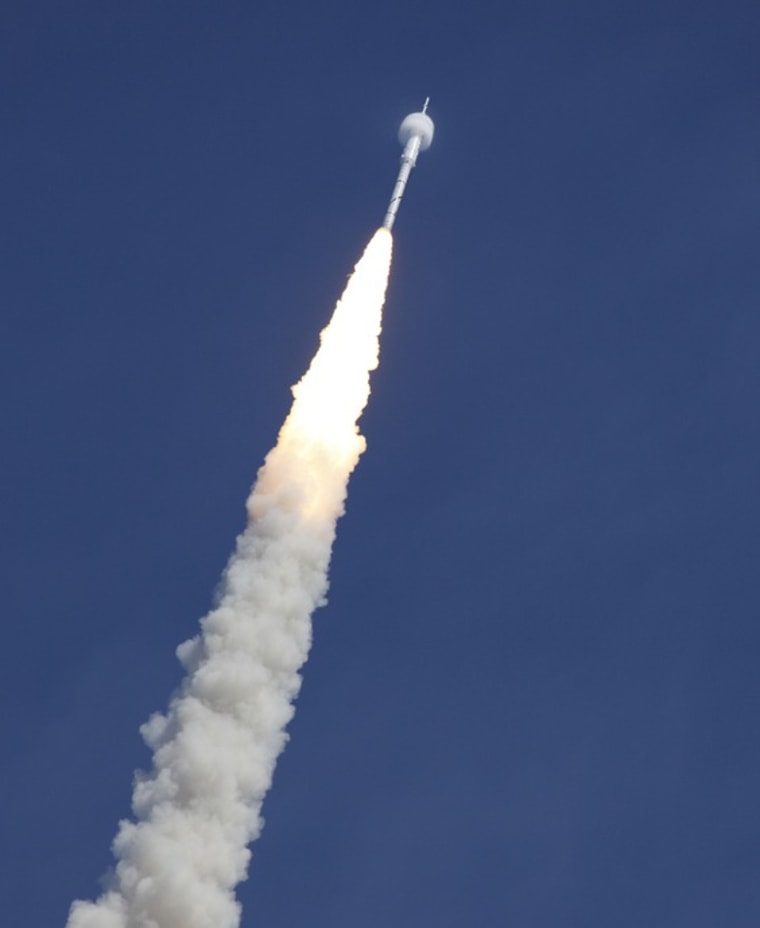As the administration of President Barack Obama prepares to propose changes to NASA's human spaceflight program, an independent NASA safety advisory panel is warning the space agency against abandoning its current plans.
In an annual report issued Jan. 15, the Aerospace Safety Advisory Panel cautioned the United States against halting work on NASA's Ares I rocket to fund unproven commercial alternatives.
"To abandon Ares I as a baseline vehicle for an alternative without demonstrated capability nor proven superiority (or even equivalence) is unwise and probably not cost-effective," the report states.
The president's 2011 budget request goes to lawmakers on Feb. 1.
Designed to launch the Orion Crew Exploration Vehicle into low Earth orbit, Ares I is a key element of Constellation, NASA's five-year-old effort to replace the space shuttle with rockets and spacecraft optimized for the Moon.
The Aerospace Safety Advisory Panel report praises Ares I as a vehicle "designed from the beginning with a clear emphasis on safety" and notes approvingly "that Time magazine cited the Ares rocket as the 'best invention of 2009.'"
The future of Ares I, however, came into question last year when a White House-appointed committee led by former Lockheed Martin chief Norm Augustine urged Obama to consider dropping Ares I in favor of paying commercial firms to transport astronauts to the international space station.
NASA awarded a pair of contracts totaling $3.5 billion in December 2008 to Dulles, Va.-based Orbital Sciences Corp. and Hawthorne, Calif.-based Space Exploration Technologies (SpaceX) to haul cargo to the space station aboard unmanned vehicles the companies say could evolve to carry people.
SpaceX, in particular, has been urging NASA to commit billions of dollars to fostering development of commercial crew launch services through the expansion of the Commercial Orbital Transportation Services (COTS) the agency created in 2006 to subsidize development of new cargo delivery systems. SpaceX and Orbital stand to receive a combined $450 million under the COTS program for their competing unmanned systems by the time the two complete demonstration cargo flights.
While the Aerospace Safety Advisory Panel report notes satisfication with the COTS program's evolution, progress and demo-first approach, the panel expressed concerns about NASA expanding COTS in the absence of a clear human-rating process for commercial vehicles.
Specifically, it says NASA's current procedures "were not specifically intended to establish requirements for vehicles produced by entities external to NASA, such as COTS firms or international programs."
The panel recommends NASA accelerate its efforts to develop a human-rating process for would-be commercial providers.
"It is the Panel's position that no COTS manufacturer is currently [human-rating-requirements] qualified, despite some claims and beliefs to the contrary," the report states. "Questions that must be answered are: What is the process for certifying that potential COTS vehicles are airworthy and capable of carrying astronauts into space safely? [and] How is compliance assured over the life of the activity?"
The panel also took issue with the Augustine committee's decision to embrace the outsourcing of human spaceflight without having conducted a safety analysis of the commercial concepts SpaceX and others presented to the committee last summer.
"In making this recommendation, the [Augustine] committee also noted that while human safety never can be absolutely assured, safety was assumed to be a 'given,'" the report says. "The Panel believes that this assumption is premature and oversimplifies a complex and challenging problem because there is not a 'cookie-cutter approach' to safety in space."
Slideshow 12 photos
Month in Space: January 2014
The report points to the Ares I program as an example of the right way to go about ensuring astronaut safety.
"Its architecture was selected by NASA's Exploration System Architecture Study (ESAS) team because of its potential to deliver at least 10 times the level of crew safety as the current shuttle," the report says. "The launch vehicle configuration has been developed to provide the best possible allowances for crew escape in the event of a launch failure. The independent launch escape system pulls the capsule clear of the launch pad and any attendant explosion or fire. The demonstrated high reliability of the solid rocket booster (SRB) suggests a low likelihood of first stage failure on ascent, but the launch escape system would cover even this low probability of failure."
The panelists warn that switching from a "well-designed, safety optimized" system to commercially-developed vehicles based on "nothing more than unsubstantiated claims would seem a poor choice," according to the report. "Before any change is made to another architecture, the inherent safety of that approach must be assessed to ensure that it offers a level of safety equal to or greater than the program of record."
The report also warned against extending the life of NASA's fleet of aging space shuttle orbiters "significantly" beyond their planned September 2010 retirement absent a thorough vehicle recertification effort.
"With sufficient money, manpower, and recertification efforts, it is possible that the Shuttle could be extended," the report states. "While we are aware of no major systems that are 'on the knee of the curve' of wear out, the funds needed to allow full recertification are substantial, and the probability of finding things that demand even more resources during recertification is very real."
NASA plans to launch five more shuttle missions by October, shut down the program and transfer the three orbiters to museums and science centers.
Once the shuttles stop flying, NASA intends to buy rides for its astronauts on Russian Soyuz vehicles until a new service — either commercial or government — materializes.

